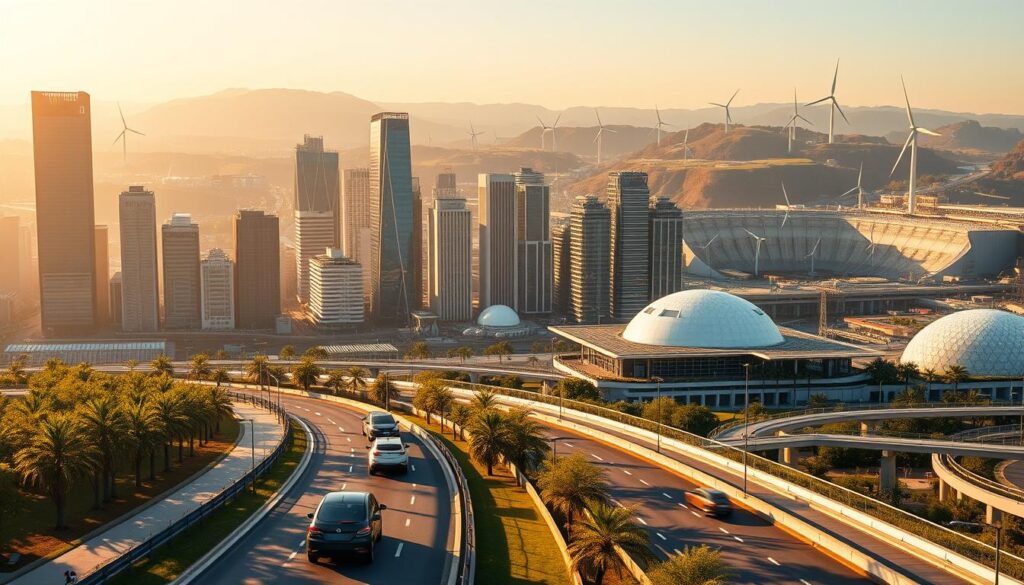As the world grapples with the escalating challenges of climate change, the need for sustainable infrastructure solutions has become more pressing than ever. Rising temperatures and extreme weather events are forcing cities to rethink their urban development strategies to ensure they can withstand and adapt to these changes.
The construction industry, being one of the largest consumers of natural resources and a significant contributor to greenhouse gas emissions, is at the forefront of this challenge. By adopting innovative and eco-friendly materials and practices, such as those highlighted on World Civil Society, cities can reduce their environmental footprint while enhancing their resilience to climate change.
Key Takeaways
- Climate change necessitates a shift towards sustainable urban development.
- Sustainable infrastructure solutions can significantly reduce environmental impact.
- Innovative materials and practices are crucial for climate-resilient cities.
- Adopting eco-friendly construction methods can enhance urban resilience.
- Sustainable building practices can reduce energy consumption and greenhouse gas emissions.
Understanding Climate Resilience in Urban Settings
As the world grapples with the challenges of climate change, understanding climate resilience in urban settings has become a critical aspect of modern civil engineering. The increasing frequency and severity of weather events due to climate change are having profound impacts on urban infrastructure, making the concept of climate resilience crucial for sustainable urban development.
Defining Climate Resilience
Climate resilience refers to the ability of urban systems to withstand, recover, and adapt in the face of climate-related stresses and shocks. It involves enhancing the capacity of cities to manage climate risks through robust infrastructure, effective governance, and community engagement. Urban resilience engineering plays a pivotal role in this context by focusing on the design and implementation of infrastructure that can resist and recover from the impacts of climate change.
Importance of Urban Development
Urban development is critical for economic growth, social progress, and environmental sustainability. However, the rapid pace of urbanization also increases the vulnerability of cities to climate change. Therefore, integrating climate change adaptation into urban planning is essential to ensure that cities can continue to thrive despite the challenges posed by a changing climate.
According to a report by PreventionWeb, sustainable urban development is key to enhancing climate resilience. The report highlights the need for a comprehensive approach to urban planning that incorporates climate risk management.
Key Statistics on Urban Vulnerability
| Statistic | Description | Impact |
|---|---|---|
| 1 billion+ | Urban population exposed to climate-related disasters | High risk of damage to infrastructure and loss of life |
| 70% | Projected global population living in urban areas by 2050 | Increased strain on urban infrastructure and services |
| $1 trillion+ | Annual economic loss due to climate-related disasters in cities | Significant economic burden on cities and nations |
These statistics underscore the urgent need for cities to adopt climate-resilient practices in urban planning and development. By understanding and addressing the factors that contribute to urban vulnerability, cities can take proactive steps to enhance their resilience to climate change.
Innovative Materials for Sustainability
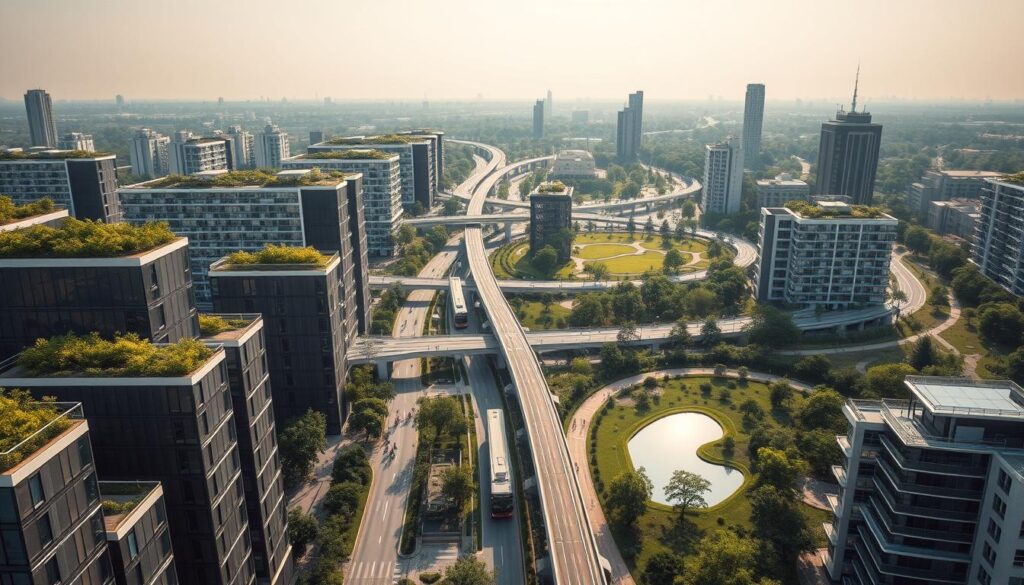
Innovative materials are revolutionizing the field of civil engineering, enabling the creation of more sustainable infrastructure. The use of such materials is crucial in addressing the challenges posed by climate change, enhancing the resilience of urban environments.
High-Performance Concrete
High-performance concrete (HPC) is a significant advancement in the field of civil engineering, offering enhanced durability and sustainability. HPC is designed to have superior mechanical properties and greater resistance to environmental factors, reducing the need for frequent repairs and replacements. This not only conserves resources but also minimizes the environmental impact associated with concrete production and disposal.
Recycled Construction Materials
The use of recycled construction materials is another innovative approach to achieving sustainability in civil engineering. Materials such as recycled aggregate, reclaimed wood, and recycled metal can significantly reduce the demand for virgin materials, lowering the environmental footprint of construction projects. Moreover, recycling construction waste reduces landfill waste and the energy required to produce new materials.
Smart Materials
Smart materials represent a cutting-edge technology in civil engineering, capable of responding to environmental stimuli. These materials can adapt to changing conditions, improving the performance and safety of infrastructure. Examples include self-healing concrete, shape-memory alloys, and thermochromic materials, which can enhance energy efficiency and reduce maintenance needs.
The integration of these innovative materials into civil engineering projects is a step towards sustainable infrastructure solutions. By leveraging high-performance concrete, recycled construction materials, and smart materials, engineers can design and build infrastructure that not only withstands the challenges of climate change but also contributes to a more sustainable future.
Green Infrastructure for Urban Areas
As cities continue to grow, the importance of integrating green infrastructure into urban planning cannot be overstated. Green infrastructure incorporates natural systems into urban areas to combat climate impacts, including features like green roofs and vegetated swales.
Benefits of Green Roofs
Green roofs provide numerous benefits, including reducing urban heat island effects and improving air quality. They also offer additional insulation, reducing energy consumption in buildings.
- Stormwater Management: Green roofs can retain rainwater, reducing stormwater runoff.
- Biodiversity: They provide habitats for various species in urban environments.
- Aesthetic Appeal: Green roofs enhance the visual appeal of urban landscapes.
Bioretention Systems
Bioretention systems, such as rain gardens, are designed to capture and filter stormwater runoff. These systems help in reducing pollutants entering water bodies and recharge groundwater.
- Efficient Water Management: Bioretention systems manage stormwater effectively.
- Improved Water Quality: They filter out pollutants from stormwater.
Urban Tree Canopy
The urban tree canopy plays a crucial role in mitigating climate change impacts. Trees absorb carbon dioxide, provide shade, and improve air quality.
- Climate Regulation: Trees help regulate urban temperatures.
- Community Benefits: Urban forests enhance community well-being and provide recreational spaces.
By incorporating these green infrastructure elements, cities can enhance their resilience to climate change, improve the quality of life for residents, and create sustainable urban environments.
Energy Efficiency in Building Design
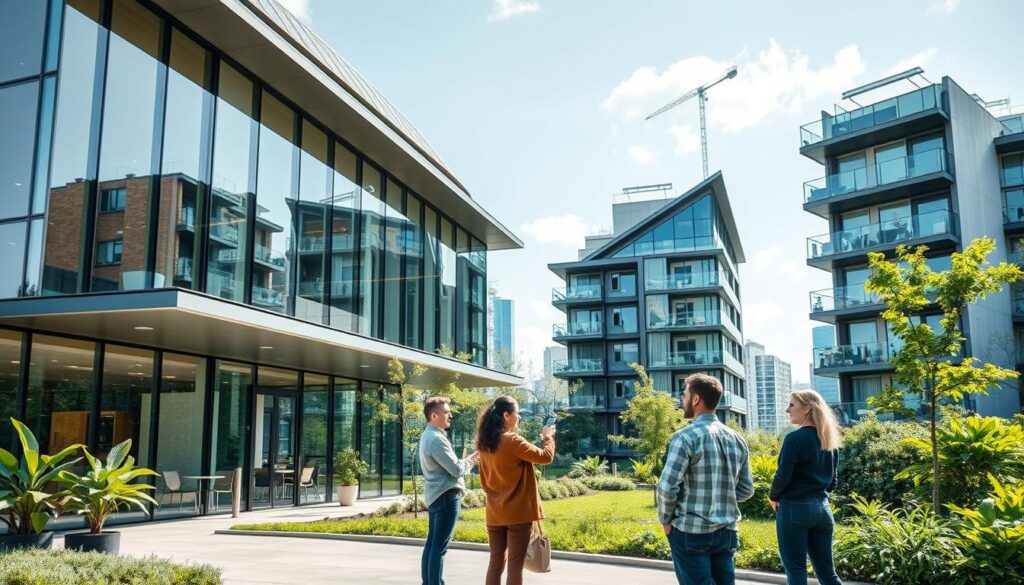
Energy efficiency is becoming a cornerstone in modern building design, driven by the need for sustainable urban development strategies. As urban areas continue to grow, the importance of designing buildings that minimize energy consumption while maximizing comfort and functionality cannot be overstated. This approach not only reduces the environmental impact of urban development but also contributes to climate-resilient infrastructure by decreasing reliance on non-renewable energy sources.
Passive Solar Design
One of the key strategies in energy-efficient building design is passive solar design. This technique involves orienting buildings and designing their envelopes to maximize natural heating and cooling. By carefully planning the placement of windows, the use of shading devices, and the selection of materials with appropriate thermal mass, buildings can significantly reduce their need for mechanical heating and cooling systems.
- Optimize window placement for natural light and heat.
- Use shading devices to reduce summer heat gain.
- Select materials with high thermal mass for temperature regulation.
Sustainable HVAC Systems
While passive solar design reduces the need for mechanical systems, sustainable HVAC systems play a crucial role in further enhancing energy efficiency. Modern HVAC systems are designed to provide high performance while minimizing energy consumption. Technologies such as heat pumps, radiant cooling, and displacement ventilation offer significant improvements over traditional HVAC systems.
| HVAC Technology | Description | Energy Savings |
|---|---|---|
| Heat Pumps | Transfer heat rather than generate it | Up to 50% |
| Radiant Cooling | Cooling through radiant heat transfer | Up to 30% |
| Displacement Ventilation | Ventilation that reduces the need for cooling | Up to 20% |
Energy-Efficient Insulation
Energy-efficient insulation is another critical component of building design that contributes to overall energy efficiency. Proper insulation reduces heat loss in the winter and heat gain in the summer, thereby decreasing the load on HVAC systems. Advanced insulation materials and techniques, such as vacuum insulated panels and reflective insulation, offer superior performance compared to traditional insulation methods.
By incorporating these energy-efficient design strategies, buildings can significantly reduce their energy consumption, contributing to a more sustainable urban environment. As the trend towards incorporating renewable energy systems into infrastructure continues, including solar-powered roads and buildings, the potential for creating truly climate-resilient urban landscapes expands.
Water Management in Climate-Resilient Design
As cities face increasing climate challenges, water management becomes a critical component of resilient design. Effective water management is essential for mitigating the impacts of climate change on urban infrastructure.
Stormwater Management Techniques
Stormwater management is a crucial aspect of urban water management. Techniques such as permeable pavements, green roofs, and bioswales help reduce stormwater runoff, alleviating pressure on urban drainage systems. Implementing these techniques can significantly enhance urban infrastructure resiliency planning.
- Permeable pavements allow rainwater to percolate through the surface, reducing runoff.
- Green roofs retain rainwater, reducing the burden on drainage systems.
- Bioswales capture and filter stormwater, improving water quality.
Rainwater Harvesting Systems
Rainwater harvesting systems collect and store rainwater for various uses, such as irrigation, toilet flushing, and even drinking water. These systems reduce the demand on municipal water supplies and decrease stormwater runoff. For more information on designing urban water projects, visit ASCE’s article on urban water projects.
- Rainwater harvesting reduces the strain on municipal water supplies.
- Stored rainwater can be used for non-potable purposes, reducing water bills.
Green Wastewater Recycling
Green wastewater recycling involves treating wastewater for reuse in irrigation, toilet flushing, and other non-potable purposes. This approach not only conserves water but also reduces the environmental impact of wastewater discharge. By adopting green wastewater recycling, cities can enhance their climate change adaptation in civil engineering efforts.
- Wastewater recycling reduces the amount of wastewater discharged into water bodies.
- Treated wastewater can be reused for various purposes, conserving freshwater resources.
In conclusion, effective water management through stormwater management techniques, rainwater harvesting systems, and green wastewater recycling is vital for climate-resilient design. By implementing these strategies, cities can improve their resilience to climate change and create a more sustainable urban environment.
Smart Technology in Civil Engineering
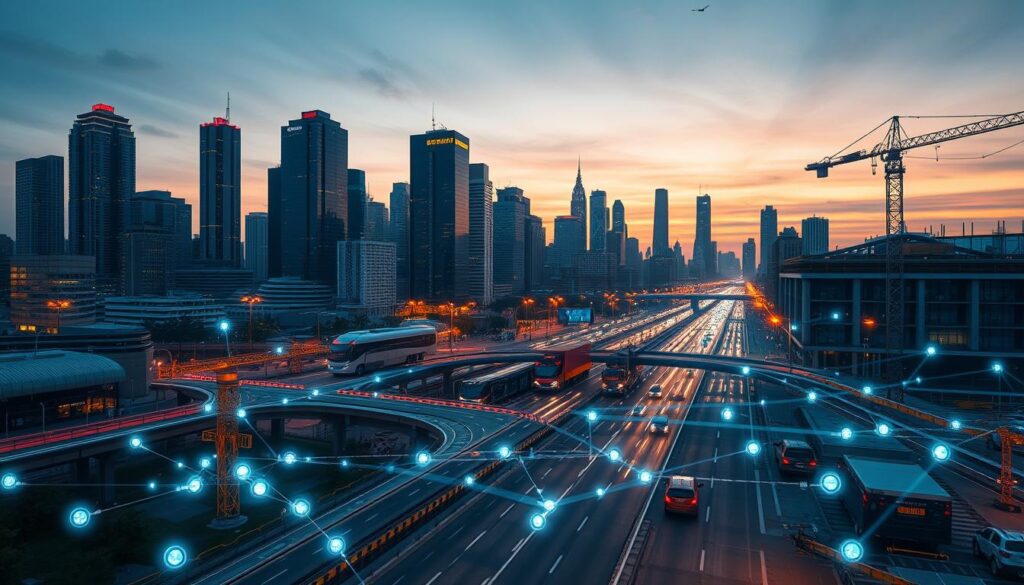
The integration of smart technology is revolutionizing the field of civil engineering, enabling the creation of more resilient and sustainable urban infrastructure. Advanced technologies like IoT, smart grids, and 3D printing are playing a pivotal role in designing climate-resilient infrastructure.
Role of IoT in Urban Planning
The Internet of Things (IoT) is transforming urban planning by providing real-time data on infrastructure performance, traffic flow, and environmental conditions. This data enables engineers to make informed decisions, optimizing urban development for sustainability and resilience. For instance, IoT sensors can monitor the structural health of buildings, detecting potential issues before they become critical.
According to a report, the use of IoT in urban planning can lead to significant improvements in infrastructure management, reducing maintenance costs by up to 30%. The integration of AI further enhances this, allowing for predictive maintenance and more efficient resource allocation.
Smart Grids Explained
Smart grids represent a significant advancement in energy management, allowing for real-time monitoring and optimization of energy distribution. This technology is crucial for supporting the increased demand for electricity in urban areas, particularly as cities adopt more electric vehicles and renewable energy sources.
| Feature | Traditional Grid | Smart Grid |
|---|---|---|
| Monitoring | Manual, periodic checks | Real-time, automated |
| Energy Efficiency | Limited optimization | Highly optimized |
| Reliability | Prone to outages | Self-healing capabilities |
3D Printing in Construction
3D printing technology is revolutionizing the construction industry by enabling the rapid creation of complex building components. This not only accelerates the construction process but also reduces material waste and allows for the use of sustainable materials.
The application of 3D printing in construction is expected to grow significantly, with potential benefits including reduced labor costs and improved precision. As the technology advances, it is likely to play a key role in the development of climate-resilient infrastructure.
Incorporating Nature-Based Solutions
As cities face growing climate challenges, nature-based solutions are being adopted to enhance resilience. Incorporating natural ecosystems into urban planning is a strategy that not only mitigates the effects of climate change but also improves the quality of life for urban residents.
Ecosystem Restoration
Ecosystem restoration involves rehabilitating degraded or damaged ecosystems to restore their natural functions. This process can significantly enhance biodiversity, improve water quality, and increase the resilience of urban areas to climate-related stressors. Recent studies have shown that restored ecosystems can provide numerous benefits, including carbon sequestration, flood mitigation, and improved air quality.
Some key strategies for ecosystem restoration include:
- Reintroducing native plant species to urban areas
- Restoring wetlands and other natural habitats
- Improving soil quality through sustainable practices
Urban Wetlands
Urban wetlands are critical components of green infrastructure in urban areas. They provide numerous benefits, including stormwater management, water filtration, and habitat creation for wildlife. Urban wetlands can also serve as recreational areas, enhancing the quality of life for residents.
The benefits of urban wetlands include:
- Effective stormwater management, reducing urban flooding
- Improved water quality through natural filtration processes
- Enhanced biodiversity and habitat creation
Coastal Resilience Projects
Coastal resilience projects focus on protecting and restoring coastal ecosystems to enhance their ability to withstand climate-related stressors. These projects often involve the restoration of dunes, mangroves, and other coastal habitats that provide natural barriers against storms and sea-level rise.
Examples of coastal resilience projects can be found in various parts of the world, including innovative ecological engineering projects that demonstrate the effectiveness of nature-based solutions in enhancing coastal resilience.
By incorporating nature-based solutions such as ecosystem restoration, urban wetlands, and coastal resilience projects, cities can significantly enhance their resilience to climate change. These strategies not only provide environmental benefits but also contribute to the social and economic well-being of urban communities.
Community Engagement in Development Projects
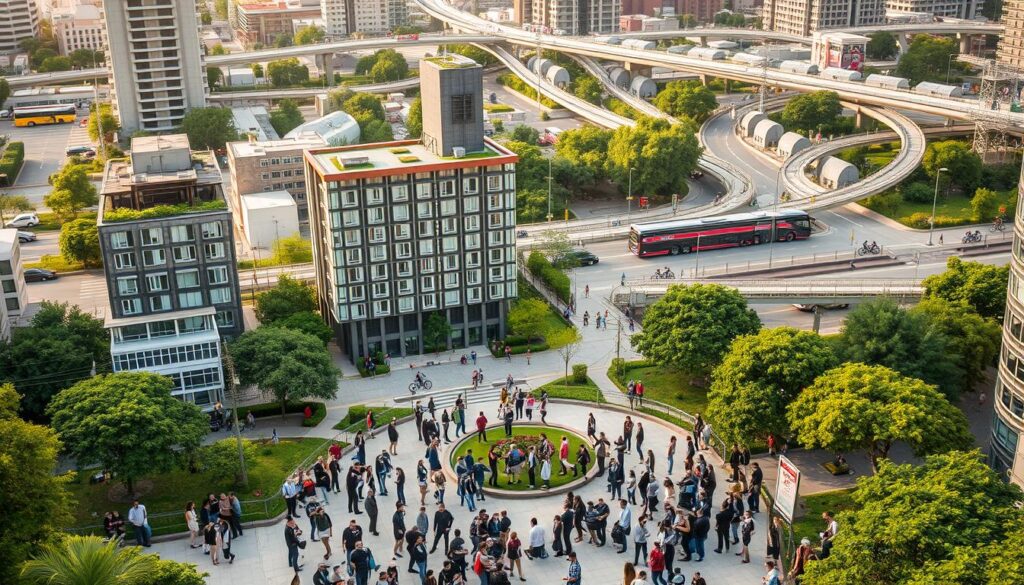
In the realm of urban development, community engagement stands out as a critical factor that determines the success and sustainability of projects. Effective community involvement ensures that development initiatives are aligned with the needs and aspirations of the local population, thereby enhancing their impact and acceptance.
Importance of Local Input
Local input is invaluable in shaping development projects that are contextually relevant and beneficial to the community. By engaging with local residents, planners can gain insights into the specific needs, concerns, and preferences of the community, which can inform the design and implementation of projects.
Community feedback can help identify potential issues early on, allowing for adjustments to be made to mitigate risks and improve project outcomes. Moreover, involving the community in the decision-making process fosters a sense of ownership and responsibility, which can lead to increased support and participation in development initiatives.
Workshops and Public Hearings
Workshops and public hearings are essential tools for facilitating community engagement. These forums provide opportunities for residents to learn about proposed projects, ask questions, and express their opinions. By hosting such events, developers can ensure that the community is well-informed and actively involved in the planning process.
These engagement activities not only help in gathering valuable feedback but also in building trust between the community and project developers. Transparent communication and the willingness to incorporate community suggestions can significantly enhance the credibility and acceptability of development projects.
Building Trust and Transparency
Building trust and transparency is crucial in community engagement. This can be achieved by maintaining open lines of communication, providing clear and accurate information, and being responsive to community concerns. When the community perceives that their voices are being heard and their concerns are being addressed, it fosters a positive relationship between the community and project stakeholders.
Transparency in decision-making processes and project planning can further enhance trust. By being open about the project’s goals, challenges, and progress, developers can create a collaborative environment that is conducive to successful project implementation.
Through these strategies, community engagement can significantly contribute to the development of sustainable urban development strategies and enhance urban resilience engineering efforts, ultimately leading to more resilient and sustainable urban environments.
Transportation Innovation for Resilience
Innovative transportation solutions are key to enhancing urban infrastructure resiliency planning. As cities grow and climate change impacts become more pronounced, the need for resilient transportation systems becomes increasingly critical.
Electric and Autonomous Vehicles
The adoption of electric and autonomous vehicles is transforming the transportation landscape. Electric vehicles reduce greenhouse gas emissions, while autonomous vehicles can improve safety and efficiency. Together, they represent a significant step towards climate-resilient infrastructure design.
Benefits of Electric and Autonomous Vehicles:
- Reduced emissions
- Improved safety
- Enhanced mobility for the elderly and disabled
Sustainable Public Transit Solutions
Sustainable public transit solutions are essential for reducing reliance on personal vehicles and lowering emissions. Efficient public transit systems can significantly contribute to urban infrastructure resiliency planning.
| Solution | Benefits |
|---|---|
| Bus Rapid Transit (BRT) Systems | Reduced traffic congestion, lower emissions |
| Electric Bus Fleets | Zero tailpipe emissions, reduced operating costs |
| Enhanced Bike-Sharing Programs | Increased mobility, reduced emissions |
Walkable Urban Design
Walkable urban design is a critical component of resilient urban development. By creating pedestrian-friendly environments, cities can reduce the need for vehicular transport and enhance the quality of life for residents.
Key elements of walkable urban design include:
- Wide, pedestrian-friendly sidewalks
- Accessible public spaces
- Mixed-use development
By integrating transportation innovation with urban planning, cities can build more resilient infrastructure. This not only supports climate-resilient infrastructure design but also enhances the overall livability of urban areas.
Incorporating Climate Data in Planning
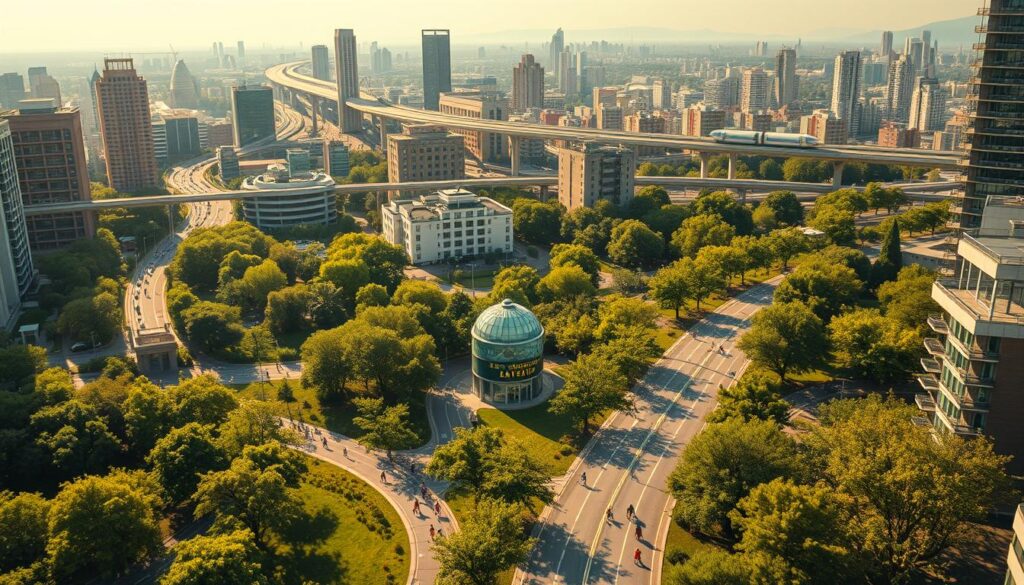
Climate change adaptation in civil engineering hinges on the ability to incorporate accurate climate data into planning. This involves utilizing various tools and strategies to ensure that urban development is resilient to the impacts of climate change.
Using Climate Models
Climate models are essential for predicting future climate conditions, allowing urban planners to make informed decisions. These models provide insights into potential temperature changes, sea-level rise, and extreme weather events, which are critical for designing infrastructure that can withstand future climate conditions.
For instance, a report by NIST highlights the importance of using climate models to inform urban planning decisions, ensuring that infrastructure is designed to be resilient to projected climate changes.
Risk Assessment Tools
Risk assessment tools are vital for identifying potential climate-related hazards and evaluating their impact on urban infrastructure. These tools help planners prioritize mitigation efforts and allocate resources effectively.
The use of risk assessment tools involves analyzing data on climate-related risks, such as flooding, heatwaves, and droughts, to develop strategies that minimize these risks. By understanding the potential impacts of climate change, cities can develop proactive measures to enhance resilience.
Long-Term Planning Strategies
Long-term planning strategies are crucial for ensuring that urban development is aligned with climate change projections. This involves incorporating climate resilience into urban planning frameworks, zoning regulations, and building codes.
Effective long-term planning also requires collaboration among various stakeholders, including government agencies, private developers, and community groups. By working together, cities can develop comprehensive plans that address the challenges posed by climate change.
| Strategy | Description | Benefits |
|---|---|---|
| Using Climate Models | Predicting future climate conditions to inform urban planning | Enhanced resilience to climate change impacts |
| Risk Assessment Tools | Identifying and evaluating climate-related hazards | Prioritized mitigation efforts and resource allocation |
| Long-Term Planning | Incorporating climate resilience into urban planning frameworks | Comprehensive and sustainable urban development |
By incorporating climate data into planning, cities can develop effective strategies for climate change adaptation, enhancing the resilience of urban infrastructure and improving the quality of life for residents.
Economic Benefits of Resilient Urban Development
The economic advantages of resilient urban development are multifaceted. Resilient urban development not only contributes to environmental sustainability but also fosters economic growth through various channels.
Job Creation Through Sustainable Practices
Sustainable infrastructure solutions are a significant driver of job creation in urban areas. By investing in green infrastructure, cities can create new employment opportunities in construction, maintenance, and management of sustainable projects. For instance, the development of green roofs and urban parks not only provides jobs but also enhances the quality of life for urban residents.
Cost Savings from Preventative Engineering
Urban resilience engineering involves designing infrastructure that can withstand the impacts of climate change, thereby reducing the need for costly repairs and reconstruction. Preventative engineering measures, such as flood-resistant construction and smart drainage systems, can significantly reduce the economic losses associated with natural disasters. This proactive approach to urban development can lead to substantial cost savings over time.
Attracting Investments
Cities that prioritize resilient urban development are more attractive to investors. The incorporation of sustainable infrastructure solutions and urban resilience engineering practices signals a city’s commitment to long-term sustainability, making it a more appealing destination for businesses and investors. This can lead to increased investment in urban development projects, further boosting the local economy.
In conclusion, the economic benefits of resilient urban development are clear. By focusing on job creation through sustainable practices, cost savings from preventative engineering, and attracting investments, cities can achieve significant economic advantages while contributing to a more sustainable future.
Regulatory Frameworks Supporting Resilience
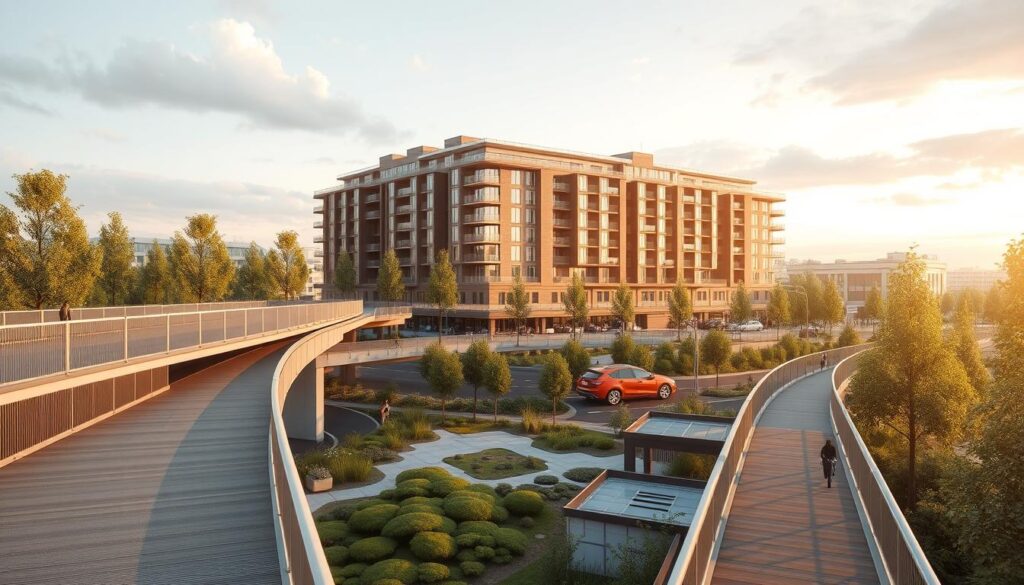
Regulatory frameworks are the backbone of resilient city planning and design, ensuring that urban development is both sustainable and adaptable to climate change. These frameworks encompass a range of policies, laws, and standards that guide urban development towards resilience.
Zoning Laws and Urban Policies
Zoning laws and urban policies are critical components of regulatory frameworks that support resilient city planning. They dictate how land is used, ensuring that development is aligned with the needs of the community and the environment.
- Land-use planning: Zoning laws regulate the types of activities that can occur in different areas, reducing the risk of incompatible land uses.
- Density and height restrictions: These regulations help manage the intensity of development, ensuring that infrastructure can support the population.
- Mixed-use development: Encouraging a mix of residential, commercial, and recreational spaces can enhance the resilience of urban areas.
Building Codes and Standards
Building codes and standards are essential for ensuring that infrastructure is designed and constructed to withstand the impacts of climate change. These codes provide detailed requirements for building design, materials, and construction practices.
Key aspects of building codes include:
- Structural integrity and durability
- Energy efficiency and sustainability
- Adaptability to future climate conditions
Federal and State Initiatives
Federal and state initiatives play a vital role in supporting climate-resilient infrastructure design through funding, technical assistance, and policy guidance. These initiatives help local governments develop and implement resilient urban planning strategies.
Examples include:
- Federal funding for climate resilience projects
- State-level policies promoting sustainable development
- Technical assistance programs for local governments
Case Studies in Climate-Resilient Engineering
In the quest for sustainable urban development, climate-resilient engineering has emerged as a key strategy, backed by compelling case studies. These examples not only demonstrate the effectiveness of innovative engineering practices but also highlight the potential for replication in various urban settings.
Successful Urban Projects in the U.S.
The United States has seen numerous successful urban projects that incorporate climate-resilient engineering. For instance, the redevelopment of the Houston waterfront after Hurricane Harvey included innovative flood protection measures and sustainable urban design principles. Such projects demonstrate how climate-resilient engineering can be integrated into urban planning to mitigate the effects of extreme weather events.
- The Boston Waterfront Resilience Project, which includes sea walls and flood gates to protect against storm surges.
- The Los Angeles River Revitalization Plan, focusing on restoring natural habitats and improving flood management.
International Examples Worth Noting
Internationally, cities have also adopted climate-resilient engineering practices with significant success. Rotterdam’s flood protection measures, for example, have become a model for other cities facing similar challenges. The city’s use of green infrastructure and adaptive flood management systems showcases the potential for sustainable urban development in the face of climate change.
- Singapore’s Marina Barrage, a dam that helps manage water supply and flood control.
- Venice’s MOSE Project, aimed at protecting the city from high tides and flooding.
These case studies underscore the importance of climate-resilient engineering in creating sustainable and resilient urban environments. By learning from these examples, cities around the world can develop their own strategies for mitigating the impacts of climate change.
Overcoming Challenges in Implementation
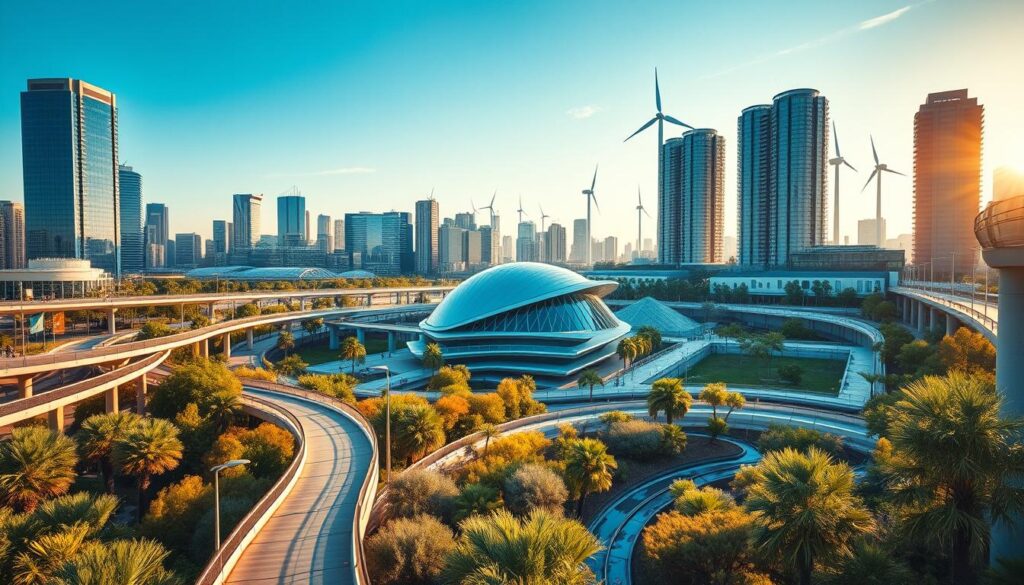
Despite its importance, climate-resilient infrastructure faces significant implementation challenges. Urban infrastructure resiliency planning is a complex process that requires careful consideration of various factors, including financial constraints, technical expertise, and community resistance.
Financial Constraints
One of the primary challenges in implementing climate-resilient infrastructure is financial constraints. The cost of designing and building resilient infrastructure can be prohibitively expensive, making it difficult for cities to allocate the necessary funds. However, there are strategies that can help mitigate these costs, such as public-private partnerships and innovative financing models.
For instance, a study on the economic benefits of resilient urban development highlights the potential for cost savings through preventative engineering. By investing in resilient infrastructure, cities can avoid costly repairs and damages in the long run.
| Financial Strategy | Description | Benefits |
|---|---|---|
| Public-Private Partnerships | Collaboration between government agencies and private companies to fund infrastructure projects. | Increased funding, reduced financial burden on taxpayers. |
| Innovative Financing Models | New financial instruments and models that help fund resilient infrastructure projects. | Access to new funding sources, flexible repayment terms. |
Technical Expertise
Another challenge is the lack of technical expertise in designing and implementing climate-resilient infrastructure. As civil engineering continues to evolve, professionals need to stay updated with the latest technologies and methodologies.
Training programs and workshops can help bridge this gap by providing engineers with the necessary skills to design and build resilient infrastructure. Moreover, leveraging smart technologies and data analytics can enhance the efficiency and effectiveness of these projects.
Community Resistance
Community resistance is another significant challenge that can hinder the implementation of climate-resilient infrastructure projects. Engaging with local communities and addressing their concerns is crucial to gaining their support.
Effective community engagement strategies include public hearings, workshops, and transparent communication about the benefits of resilient infrastructure. By building trust and demonstrating the value of these projects, cities can overcome resistance and ensure successful implementation.
In conclusion, while there are challenges to implementing climate-resilient infrastructure, there are also opportunities for innovation and growth. By addressing financial constraints, enhancing technical expertise, and engaging with communities, cities can build a more resilient future.
Future Trends in Civil Engineering
The future of civil engineering is poised to revolutionize urban development through the integration of cutting-edge technologies and sustainable practices. As cities continue to grow, adopting modern civil engineering practices for climate-resilient urban development will be crucial in mitigating the impacts of climate change.
Emerging Technologies
Artificial intelligence (AI) and machine learning are set to play a significant role in analyzing data to predict and prevent infrastructure failures. Innovative engineering for climate change mitigation will rely heavily on these technologies to create more resilient infrastructure.
Drones in Urban Planning
Drones are being increasingly used in urban planning to survey sites, monitor construction progress, and inspect infrastructure. This technology enhances the efficiency and accuracy of civil engineering projects.
Anticipating Climate Change Impacts
As climate change continues to pose significant challenges, civil engineers must anticipate and prepare for its impacts. By leveraging advanced simulation tools and data analytics, cities can develop infrastructure that is not only resilient but also sustainable.
By embracing these future trends, the civil engineering industry can drive modern civil engineering practices for climate-resilient urban development, ultimately creating a more sustainable future for urban communities.
